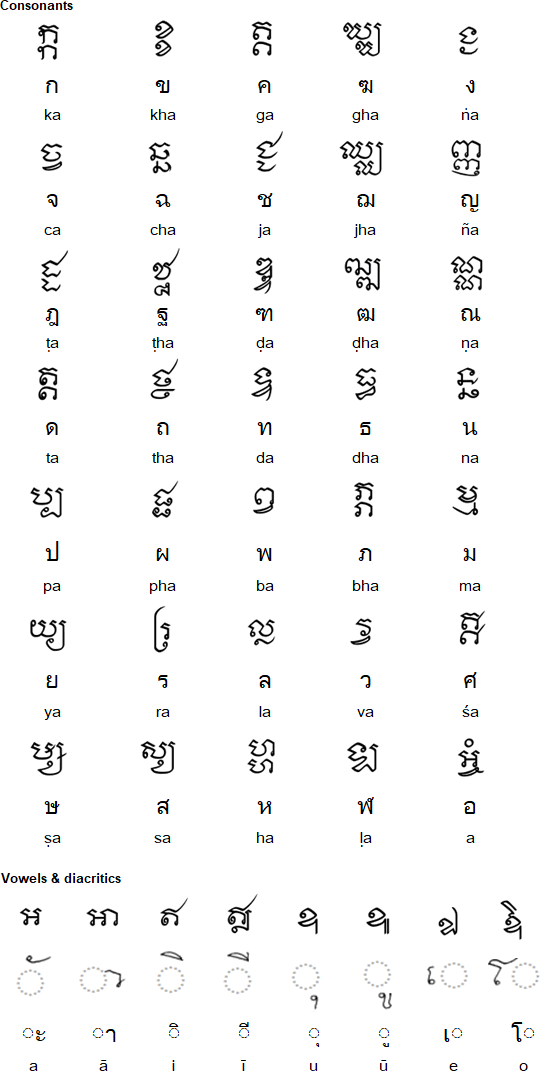
The Khom Thai script is a descendant of the Old Khmer script that developed in the 15th century as a way to write Thai. Before then, Thai was written with the Khmer script and later the Sukhothai script, which were not ideal due to phonological differences between Thai and Khmer. In the 15th century, the Khmer script was modified with the addition of extra letters to better represent Thai. The new script was named Khom Thai, which means "Thai Khmer".
The Khom Thai script was used particularly to write religious texts in Pali, Sanskrit, Thai, Isan and Khmer, while the Thai script, which developed from the Sukhothai script around the same time, was used for non-religious texts. Both scripts continued to be used until the 19th century, when King Rama IV (1804-1868) ordered Buddhist monks in Thailand to write Pali with the Thai script rather than the Khom Thai script. Later, King Rama V (1853-1910) ordered the translation of the Tripiṭaka, a sacred Buddish text, from Pali into Thai using the Thai script. Then use of the Khom Thai script in the Buddhist studies exam was scrapped. This was reinstated in 1918, and then the exam itself was scrapped in 1945 by the Thai Ministry of Education.
The Khom Thai script was used for Buddhist texts, talismanic images, and texts on medicine, magic, astrology, numerology, cosmology, divination and other topics. It was used particularly in Bangkok and the provinces of Ayutthaya, Nakhon Si Thammarat, Isan and Chiang Mai in central and northern Thailand, and also in Luang Prabang, Champassak and Vientiane in Laos.
Use and study of the Khom Thai script continues to some extent, however, and it is part of courses in oriental palaeography at certain universities in Thailand. The script is also used in Thailand and Cambodia to write ritualistic and symbolic texts known as yantras or mantras on cloth and paper, for engravings on brass plates, and for tattoos.

This chart shows the Khom Thai letters, their Thai equivalents, and their transliterations in the Latin script.

A poor woodcutter picks lotus flowers in a pond (right) and presents them to the monk Phra Malai (left). From: Wikimedia Commons, from wellcome collection
Information about Khom Thai
https://en.wikipedia.org/wiki/Khom_Thai_script
https://de.wikipedia.org/wiki/Khom-Thai-Schrift
https://skyknowledge.com/khomthai.htm
Khom Thai Fonts
https://eng.fontke.com/search/font/Thai%20Khom/
Ahom, Aima, Arleng, Badagu, Badlit, Basahan, Balinese, Balti-A, Balti-B, Batak, Baybayin, Bengali, Bhaiksuki, Bhujimol, Bilang-bilang, Bima, Blackfoot, Brahmi, Buhid, Burmese, Carrier, Chakma, Cham, Cree, Dehong Dai, Devanagari, Dham Lipi, Dhankari / Sirmauri, Ditema, Dives Akuru, Dogra, Ethiopic, Evēla Akuru, Fox, Fraser, Gond, Goykanadi, Grantha, Gujarati, Gunjala Gondi, Gupta, Gurmukhi, Halbi Lipi, Hanifi, Hanuno'o, Hočąk, Ibalnan, Incung, Inuktitut, Jaunsari Takri, Javanese, Kaithi, Kadamba, Kamarupi, Kannada, Kawi, Kharosthi, Khema, Khe Prih, Khmer, Khojki, Khom Thai, Khudabadi, Kirat Rai, Kōchi, Kodava Lipi, Komering, Kulitan, Kurukh Banna, Lai Tay (Tai Yo), Lampung, Lanna, Lao, Leke, Lepcha, Limbu, Lontara/Makasar, Lota Ende, Magar Akkha, Mahajani, Malayalam, Meitei (Modern), Manpuri (Old), Marchen, Meetei Yelhou Mayek, Meroïtic, Masarm Gondi, Modi, Mon, Mongolian Horizontal Square Script, Multani, Nandinagari, Newa, New Tai Lue, Ojibwe, Odia, Ogan, Pahawh Hmong, Pallava, Phags-pa, Purva Licchavi, Qiang / Rma, Ranjana, Rejang (Kaganga), Sasak, Savara, Satera Jontal, Shan, Sharda, Sheek Bakrii Saphaloo, Siddham, Sinhala, Sorang Sompeng, Sourashtra, Soyombo, Sukhothai, Sundanese, Syloti Nagri, Tagbanwa, Tai Noi, Takri, Tamil, Tanchangya (Ka-Pat), Tani, Thaana, Telugu, Thai, Thirke, Tibetan, Tigalari, Tikamuli, Tocharian, Tolong Siki, Vatteluttu, Warang Citi
Page created: 07.07.25. Last modified: 07.07.25
[top]
You can support this site by Buying Me A Coffee, and if you like what you see on this page, you can use the buttons below to share it with people you know.

If you like this site and find it useful, you can support it by making a donation via PayPal or Patreon, or by contributing in other ways. Omniglot is how I make my living.
Note: all links on this site to Amazon.com, Amazon.co.uk
and Amazon.fr
are affiliate links. This means I earn a commission if you click on any of them and buy something. So by clicking on these links you can help to support this site.
[top]